Study Of TV And AM/FM Radio Ads Reveals Sight, Sound, And Motion Superiority Is A Myth
December 7, 2022

By Pierre Bouvard
Marketers often dismiss audio advertising by noting solemnly, “We need sight, sound, and motion.” The implication: video ads generate substantially greater creative effectiveness, increased brand equity lift, and larger sales effect than an audio ad.
Auto brands say, “I need to show my car.” QSR marketers require their ads show succulent food shots. Haircare and skincare advertisers want ads showing silky hair and smooth skin.
Duncan Stewart: “Nobody looks at the evidence that doesn’t fit the narrative”
Stewart, Deloitte’s Director of Research, Technology, Media & Telecommunications, finds that often repeated media truisms are not studied. Many commonly accepted marketing beliefs seem logical.
The “sight, sound, and motion” narrative generates head nods. It sounds plausible enough. As such, no one looks at the actual data to support or disprove this widely held marketing truism.
Audio vs. video: Largest ever creative effectiveness study conducted by ABX with 10,738 TV ads and 2,779 AM/FM radio ads
To determine whether “sight, sound, and motion” trumps audio ads, ABX, the leader in syndicated advertising effectiveness, examined the largest head-to-head creative study of audio and video ads. ABX has a stunningly large normative database of 365,000+ measured ads globally, from the U.S. and 13 other countries, representing 90% of global ad spend.
ABX offers clients a continuous integrated creative feedback loop, from early creative through in-market ad and campaign evaluation against competitor ads and across all media (TV, AM/FM radio, podcasts, print, online, out of home, online video, and social media) using the same rigorous methodology. Only ABX measures ads from all media types in the same survey, allowing a clear comparison of creative effectiveness of one media type versus another, and replicating real world consumer viewing.
For the purposes of this analysis, ABX examined two years’ worth of recent testing, which totaled 40,000 ads and included 10,738 TV ads and 2,779 AM/FM radio ads.
ABX Creative Score: Four measures create overall creative effectiveness performance
The overall ABX creative score for each ad tested is comprised of four key elements:
- Brand: This measures the awareness of the brand being advertised in the ad.
- Messaging: This includes how well the ad clearly communicates the product’s benefit, and a crucial aspect of advertising effectiveness, if the ad is easy to understand.
- Reputation: This quantifies the net positive difference between those who said the ad made their opinion of the company better and those who said the ad made their opinion of the company worse.
- Take any call to action: Respondents indicate a number of actions they would be likely to take as a result of the ad (contact advertiser, visit website, look for product/service, purchase, recommend, talk to someone).
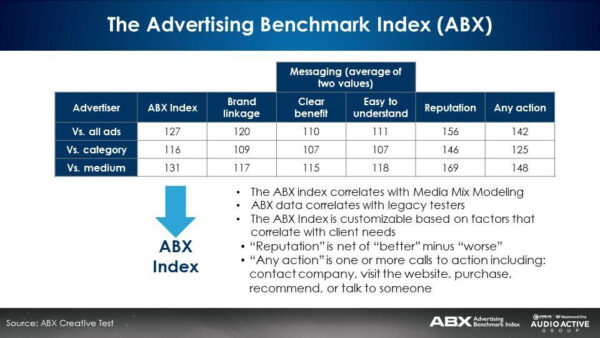
ABX: AM/FM radio creative effectiveness is 92% of TV at one-fourth of the CPM
If “sight, sound, and motion” is so impactful, one would think the TV ad creative effectiveness would be double that of AM/FM radio. In reality, TV advertising effectiveness is only 8% better than AM/FM radio at 4X the CPM. The findings are clear. “Sight, sound, and motion” do not represent a significantly greater creative effectiveness.
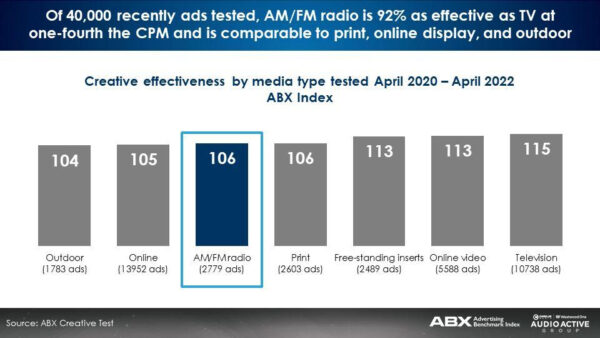
The best testing AM/FM radio ads outperform nearly half of all TV ads
Remarkably, ABX found that higher scoring AM/FM radio ads actually outperformed 48% of TV executions. As the total scores of the TV and AM/FM radio creative tests are so similar, it is not surprising AM/FM radio ads can have greater creative effectiveness than TV ads.
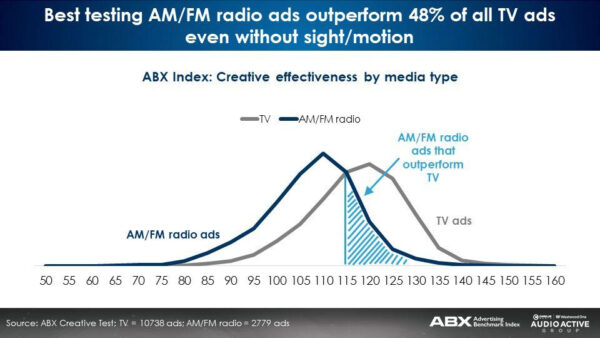
Gary Getto, President of ABX, says, “Moving some TV funds to AM/FM radio produces significantly higher reach. Often the excuse for not doing this is the need for sight, sound, and motion that TV provides and, in many cases, the lack of confidence in AM/FM radio creative’s ability to move the needle. But extensive ABX data shows that AM/FM radio can be nearly as effective as television when best practices in audio creative are followed.”
Haircare and skincare: AM/FM radio ads perform very close to TV ad effectiveness for highly visual personal care categories
ABX found that in the skincare category, AM/FM radio creative performs at 95% of TV effectiveness. In haircare, AM/FM radio performs at 89% of TV. AM/FM radio creative performs very close to TV at a fraction of TV CPMs.
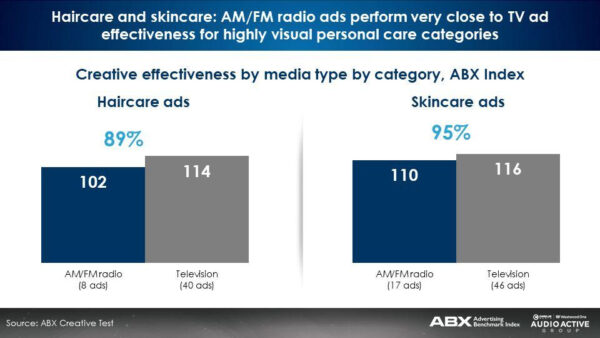
Quick service restaurants: AM/FM radio ads perform very closely to TV ads in a category that has valued beautiful shots of food
ABX measured Arby’s and Chick-fil-A’s TV and AM/FM radio ads. Across a series of measures (clear brand, message delivery, reputation, likeability, and taking action), the AM/FM radio ads performed very similarly to the TV ads at a fraction of the CPM. Even without the visual of the food, AM/FM radio ads performed just about as well as the TV ads.

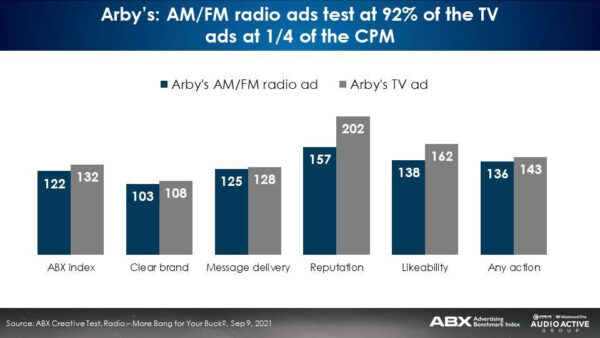
Nielsen: 61% of TV ads are not seen
Why don’t “sight, sound, and motion” TV ads significantly outperform AM/FM radio ads in creative effectiveness? A major study by Nielsen reveals a minority of TV ad impressions are “eyes on glass.” Sight, sound, and motion are rarely achieved. When TV ads are playing:
- 39% of the time the audience’s eyes are on the screen
- 40% of the time people are looking at their phone or a second screen
- 21% of the time people are out of the room
Interestingly, just as many people (40%) only hear a TV ad as those who “see” the ad (39%). Thus, half the time, that “sight, sound, and motion” TV ad is just an AM/FM radio ad! People can look away but they cannot shut their ears.

Games of Thrones: Audio trumps video in creating consumer engagement with emotion-based stories as audio book beats the TV show in consumer engagement
Published by Nature Research, a study of consumers who were exposed to video and audio narratives measured reactions with sensors placed at the wrists to measure heart rates, electrodermal activity, and body temperatures. Half of study respondents were exposed to the Games of Thrones audio book. The other half watched the TV show. The conclusion?
Consumers were far more engaged with an audio story than a video narrative. The Game of Thrones audio book audience showed greater physiological responses (heart rate, body temperature, and galvanic skin response) than viewers of the TV show.
The authors report, “Physiological responses revealed more cognitive and emotional engagement while listening to audio narratives. … spoken narratives require the participant to be an actively engaged listener, whereas videos deliver rich stimulation to a more passive viewer. The pictures in the listener’s mind [from the audio narrative] may not be as vivid and as detailed as those onscreen … yet the imaginative generation of those images requires greater cognitive and emotional processing, and so they are physiologically more engaging.”
Audio narratives require active participation to imagine the story. Video narratives require less of the audience, resulting in passive engagement. The “sight, sound, and motion” ideal that brands seek actually results in less engagement than the same ad on a podcast or AM/FM radio.
AM/FM radio creative effectiveness is nearly the same as TV for a fraction of the CPM
The results of ABX’s massive creative test are conclusive. The commonly accepted wisdom of the superiority of TV ads’ “sight, sound, and motion” to AM/FM radio ads is a myth.
Key takeaways:
- ABX: AM/FM radio creative effectiveness is 92% of TV at one-fourth of the CPM; TV ads’ “sight, sound, and motion” superiority is a myth
- The best testing AM/FM radio ads outperform nearly half of all TV ads
- Haircare and skincare: AM/FM radio ads perform very close to TV ad effectiveness for highly visual personal care categories
- Quick service restaurants: AM/FM radio ads perform very closely to TV ads in a category that has valued showing beautiful shots of food
- Nielsen: 61% of TV ads are not seen; Most exposures occur when consumers gaze at their phone or are out of the room
- Games of Thrones: Audio trumps video with greater cognitive and emotional processing as audio book beats the TV show in consumer engagement






























